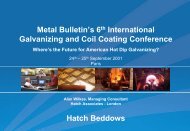Structural Assets Newsletter #21, April 2007 [pdf, 249 KB] - Hatch
Structural Assets Newsletter #21, April 2007 [pdf, 249 KB] - Hatch
Structural Assets Newsletter #21, April 2007 [pdf, 249 KB] - Hatch
You also want an ePaper? Increase the reach of your titles
YUMPU automatically turns print PDFs into web optimized ePapers that Google loves.
<strong>April</strong> <strong>2007</strong> Number 21<br />
<strong>Structural</strong> <strong>Assets</strong><br />
GROUP LEADER’S INTRODUCTION<br />
LIFE EXTENSION FOR<br />
BUCKETWHEEL RECLAIMER<br />
This is our twenty-first newsletter for <strong>Structural</strong><br />
<strong>Assets</strong> and the first edition for <strong>2007</strong>. It is amazing<br />
to see how the time has flown over the past two<br />
years since our last newsletter. There is always so<br />
much to do, with so little time left to do the things that we<br />
would like to do. It has been a couple of extremely busy<br />
years for our business, propelled by the global natural<br />
resources boom. This trend has not shown any decline<br />
and is currently looking positive for global business.<br />
The <strong>Structural</strong> <strong>Assets</strong> Group continues to provide<br />
services in the areas of:<br />
Condition assessment, life extension and third party<br />
independent design auditing of materials handling<br />
machines (Stacker Reclaimers, Stackers,<br />
Reclaimers, Shiploaders and Shipunloaders);<br />
Condition assessment and life extension of industrial<br />
structures such as bins, ducts, silos, bunkers, stacks,<br />
tipplers, overhead cranes, thickener tanks and<br />
agitator tanks; and,<br />
Risk studies, specialist engineering advise and design<br />
solutions.<br />
The objective of this newsletter is to share engineering<br />
knowledge gained during the course of our work with our<br />
customers and colleagues. We would be pleased to<br />
receive any comments or suggestions regarding this<br />
newsletter from readers by e-mail or facsimile.<br />
On behalf of the <strong>Structural</strong> <strong>Assets</strong> Group in Australia, I<br />
would like to take this opportunity to extend greetings for<br />
the upcoming Easter festivities to all of our clients, staff<br />
and their families.<br />
“We are what we repeatedly do. Excellence, then, is<br />
not an act but a habit.” — Aristotle<br />
Dr. S. Loganathan (Logan)<br />
Lloganathan@hatch.com.au<br />
A Happy and Safe<br />
Easter to All<br />
The bucketwheel reclaimer at a coal terminal was<br />
commissioned in 1977 and de-commissioned in 2002,<br />
when it was decided that due to the extent of major<br />
structural defects, for example, structural cracking in the<br />
luffing pivot, severe corrosion to bucketwheel region of<br />
the boom, and high risk for further operation, the design<br />
service life had been expended. At the time it was not<br />
considered cost effective to affect the extent of repairs<br />
necessary to allow it to continue in service with a<br />
satisfactory level of risk.<br />
General View of Bucketwheel Reclaimer<br />
In 2004, due to the worldwide increase in the demand for<br />
coal and the desire to increase throughput at the<br />
terminal, due to an ever-increasing shipping queue, two<br />
options were considered. Option one was to purchase a<br />
new bucketwheel reclaimer of the same size at an<br />
approximate cost of A$18M with a minimum lead time of<br />
two years, or, option two, return the reclaimer back to<br />
service. This would require the following major works:<br />
<strong>Structural</strong> cracking in rocker arm assembly to be<br />
repaired;<br />
Hydraulic luffing cylinders to be removed, refurbished<br />
and re-installed;<br />
Slewing bearing to be replaced;<br />
Bucketwheel, including shaft and drive assembly, to<br />
be replaced; and,<br />
Replacement of heavily corroded structural members<br />
in bucketwheel boom.<br />
Successful completion of the above would result in the<br />
extension of the service life of the machine by 25 years.<br />
The normal approach to the above tasks would be to<br />
dismantle the machine in the reverse order to that in<br />
which it was constructed. This would necessitate an<br />
extensive laydown area adjacent to the machine<br />
runway, the extended use of high capacity cranage and<br />
involve considerable construction risk.
2 <strong>Structural</strong> <strong>Assets</strong><br />
In close consultation with the construction contractor a<br />
solution was developed whereby the superstructure of<br />
the reclaimer could be lifted in situ, with the boom and<br />
counterweight still assembled, to allow the change out<br />
of the slew bearing and the repair of the rocker<br />
assembly.<br />
Many issues referred to the Brisbane design office from<br />
the construction site required detailed analysis and a<br />
design solution to be undertaken and developed within<br />
48 hours in order to meet construction milestones.<br />
The project was completed successfully and the<br />
machine has been in full operation since August 2005.<br />
The owners have expressed their appreciation of<br />
<strong>Hatch</strong>'s engineering solutions and the value created for<br />
their business.<br />
For further information contact Dr S.Loganathan<br />
(Logan) at Llogananathan@hatch.com.au<br />
Faarms REBORN<br />
Machine Jacked Up for Rocker Assembly Repair<br />
Implementation required the design and fabrication of a<br />
purpose built support frame, and other high load<br />
capacity temporary works, which incorporated a<br />
number of safety features such as strain gauges to<br />
allow the monitoring of loads during the construction<br />
process. This load measurement capability also<br />
allowed constant monitoring of the machine balance<br />
and was used to assist in the calculation of the mass of<br />
counter weights necessary to maintain stability during<br />
the construction phases when the major components<br />
were jacked apart to facilitate replacement and repair<br />
operations.<br />
The final EPCM cost of the project wasA$6M with a total<br />
project duration of twelve months from concept to end of<br />
re-commissioning. This provided the client with an<br />
immediate cost saving of A$12M, and gave further<br />
value by providing an additional throughput of 2500<br />
tonnes per hour. A minimum of twelve months prior to<br />
that which would have been possible had option one<br />
been adopted.<br />
Von Mises Stress Plot of Rocker Arm Boss<br />
To carry out the design works it was necessary for the<br />
<strong>Structural</strong> <strong>Assets</strong> group to maintain an extremely close<br />
working relationship with the owner and the<br />
construction contractor in order to complete the<br />
construction phase of the project in the six months.<br />
PDG - <strong>Structural</strong> <strong>Assets</strong> Group<br />
FAARMS<br />
Facilities And <strong>Assets</strong> Risk Management System<br />
LIFE EXTENSION - RISK REDUCTION - DESIGN SOLUTIONS<br />
Version 5 - <strong>2007</strong><br />
A new version of FAARMS has been developed by<br />
<strong>Hatch</strong> to improve auditing efficiencies for clients. The<br />
upgrade to version 5 of the system began in September<br />
2005 by <strong>Hatch</strong> programmers, and was delivered to the<br />
Wollongong office for testing in February 2006. After a<br />
number of months of testing and using it on projects, the<br />
system is ready for roll out to other offices in Australia,<br />
starting with the Brisbane, Mackay and Townsville<br />
offices that have existing auditing programs.<br />
The new version has been upgraded from a file based<br />
database (Microsoft Access) system to a client-server<br />
SQL database system with a new user interface to<br />
improve data entry. The use of the SQL database<br />
server allows for additional system stability and<br />
document storage over the old file based database.<br />
The multi-user interface allows <strong>Hatch</strong> to enter more<br />
information at one time and assists in centralising client<br />
information to fewer locations improving data security<br />
and integrity. The data can also be augmented with<br />
photos, reports and supporting documentation server<br />
location for easy access.<br />
New licensing provisions will make it possible for clients<br />
to have read only access to the information. This will<br />
assist clients who use the information for forward<br />
planning of works by allowing them to manipulate the<br />
information to their own needs while not being<br />
burdened with inefficient soft copies of spreadsheets<br />
currently provided.<br />
A new user interface has been developed to aid in data<br />
entry and to provide more flexibility. Multiple clients<br />
(users) can be individually set up in the one database to<br />
suit each client's requirements.<br />
The new entry set up also improves efficiencies in<br />
information entry and reduces time required for report<br />
preparation.
3 <strong>Structural</strong> <strong>Assets</strong><br />
Coupled with the new user interface is a reporting<br />
module with improved flexibility in report formatting to<br />
suit any requirements from multiple clients. All of the<br />
existing report formats can be maintained for existing<br />
clients and additional formats developed by any user as<br />
required.<br />
While testing is complete and further improvements<br />
have been identified the system is available for release<br />
to other <strong>Hatch</strong> offices. In the shor-term, improvements<br />
will be added to the system in the next three months with<br />
other long-term improvements being developed for<br />
inclusion in late <strong>2007</strong>.<br />
Short-term improvements build on the main upgrade<br />
and correct minor deficiencies in the user interface<br />
encountered during testing.<br />
Long-term improvements include the use of PDA<br />
(Windows Mobile Devices) entry of information in the<br />
field, comment generators to standardise condition<br />
description entries and multiple language interfaces.<br />
While the use of PDAs for entry on site will increase site<br />
time the savings in report output will be much greater,<br />
improving report turn-around, audit efficiencies and<br />
reducing costs. Using comment generators for<br />
condition descriptions will standardise the report and<br />
provide more uniformity across audit teams and offices,<br />
providing clients with greater confidence in the use of<br />
different audit teams. Multiple language (French,<br />
Spanish and Portuguese) interfaces will also help<br />
<strong>Hatch</strong> take the system internationally to all offices<br />
providing clients with a larger network of auditing<br />
resources.<br />
These long-term projects will be developed throughout<br />
<strong>2007</strong> and will be included in the system as they become<br />
available.<br />
The new version of FAARMS represents a large<br />
investment by <strong>Hatch</strong> and brings the system up to<br />
current technologies and client requirements. It is the<br />
first step in taking the old system to greater heights<br />
through more efficiencies and lower auditing costs and<br />
shows <strong>Hatch</strong>'s commitment to maintaining best<br />
practices for our clients.<br />
For further information contact Glenn Avery at<br />
gavery@hatch.com.au<br />
corrosive environment, the ducts structural integrity had<br />
been compromised. Loss of plate thickness,<br />
particularly at bends had occurred unobserved due to<br />
the ducts being insulated and over sheeted to protect<br />
the insulation.<br />
<strong>Hatch</strong> <strong>Structural</strong> <strong>Assets</strong> Group was initially engaged to<br />
assess the structural integrity of the ducts in their<br />
existing condition. In order to carry out this assessment<br />
of the structure the actual profile of the buckled duct and<br />
the temperature distribution of the ducts was required.<br />
The geometric profile was obtained from a 3D laser<br />
survey carried out by AAM<strong>Hatch</strong>. This survey produced<br />
numerous co-ordinate points on the duct shell, referred<br />
as 'point clouds', from which surface profile was<br />
derived.<br />
Laser Surface Profile<br />
The shell temperature distribution was derived by<br />
carrying out a surface thermographic survey. Based on<br />
this information, a three dimensional model was<br />
generated in MSC.FEA finite element analysis<br />
software. The relevant design loads were applied to<br />
calculate the stress in the ducts with regard to strength<br />
and local plate buckling. Analysis results revealed<br />
several regions of localized high stress as a result of<br />
which <strong>Hatch</strong> recommended that a support bridge be<br />
installed beneath the ducts to provide additional<br />
support, particularly at the buckled region of the<br />
northern duct.<br />
QNI OFF-GAS DUCTS<br />
As a result of a structural condition assessment on their<br />
nickel ore roasting facility, Queensland Nickel Limited<br />
(QNI) was made aware of the risk associated with the<br />
condition of the two metre diameter off-gas ducts.<br />
The ducts were commissioned circa 1972 and one of<br />
the ducts (northern side of the building) exhibited major<br />
buckling distortion caused by an implosion circa 1975.<br />
Anecdotal evidence suggested that the ignition of dust,<br />
which had accumulated in the duct, was the cause of<br />
the implosion. The ducts spanned approximately 30m<br />
between the roaster building and precipitator manifold<br />
support tower and approximately 20m above the<br />
ground. The ducts were only supported on saddles at<br />
each end.<br />
The nickel refinery operated on a twenty four hour a day<br />
seven day a week basis and, coupled with a highly<br />
Duct Stress Plot<br />
The risk of failure was further amplified when a major<br />
crack was detected in the northern duct shell in the<br />
lobster-back bend at the roaster end of the duct. The<br />
extent of the cracking was such that there was serious<br />
concern that if immediate repair was not implemented<br />
there was a serious risk of catastrophic structural<br />
failure. The consequence of such an occurrence would<br />
have been enormous as the area operations office, the<br />
operators crib room and a substantial pipe gallery are<br />
situated between the duct and the ground. Failure of<br />
the duct would lead to major disruption of the plant<br />
operation and have a high potential to cause a fatality.<br />
In view of the above a temporary support, cantilevered<br />
from the roaster building above the duct and located<br />
beyond the cracked bend, was installed and the design<br />
of a new lobster-back bend undertaken.
4 <strong>Structural</strong> <strong>Assets</strong><br />
Work on the support bridge design was temporarily<br />
halted while the new bend was fabricated and installed.<br />
The temporary support concept was so successful that<br />
a similar “gallows” was designed and installed at the<br />
precipitator end of the ducts to facilitate the removal of<br />
the existing contilever truss supports which were<br />
currently blocking the preferred position for the<br />
proposed support bridge.<br />
During the design phase of the project a number of<br />
alternative methods of supporting the ducts were<br />
investigated as there were many challenges to be faced<br />
some of which included the following :-<br />
Limited workspace in a highly congested refinery site;<br />
Construction had to be undertaken while the plant<br />
was in operation;<br />
Unknown design loads (i.e. the amount of dust<br />
accumulation inside the duct);<br />
Unknown foundation capacity of existing buildings<br />
from which bridge would be supported;<br />
Capacity of existing buildings to carry the new loads<br />
imposed by the support bridge; and,<br />
Working in a hostile environment.<br />
The congested work site proved to be the main<br />
limitation. This was overcome by adopting an<br />
innovative solution which worked around the site<br />
restrictions. Temporary support beams were erected at<br />
each end of the ducts to form a runway out to a slightly<br />
less congested area to the north of the ducts adjacent to<br />
one of the ore silos where crane access and<br />
manoeuvring was possible. This concept was further<br />
enhanced by the timely availability of a three hundred<br />
tonne capacity crawler crane on the site.<br />
Innovative design solution based on reducing the<br />
degree of construction difficulty;<br />
The bridge provides safe access for operation and<br />
maintenance purposes.<br />
Support Bridge in Place<br />
The design solution may not be the most sophisticated<br />
or cost effective but it is fit for purpose and was<br />
undertaken in a compressed timeframe given the<br />
operation and boundary constraints. The project was<br />
safely delivered within the allotted timeframe and<br />
budget without any loss of production or injury. For<br />
further information contact Greg Gabb at<br />
ggabb@hatch.com.au<br />
OFFICE LOCATIONS AND<br />
CONTACT PERSONS<br />
Brisbane<br />
152 Wharf Street, Brisbane, Queensland, 4000, Australia<br />
Telephone: +61 7 3834 7777<br />
Facsimile: +61 7 3832 3042<br />
Contact: Dr. S Loganathan (Logan)<br />
Townsville<br />
Greenvale Street, Yabulu, via Townsville, Queensland, 4818,Australia<br />
Telephone: +61 7 4720 6800<br />
Facsimile: +61 7 4720 6821<br />
Contact: Dr T.Langbecker<br />
Prior to Installation of Support Bridge<br />
The two pre-fabricated bridge segments were fitted with<br />
sets of beam trolley wheels and lifted into place on the<br />
temporary beams. The two bridge segment transverse<br />
diaphragms were then butt welded in-situ and the<br />
completed bridge rolled sideways along the temporary<br />
beams into its final position underneath the ducts.<br />
Once finally positioned the stricture was jacked up and<br />
the beam trolley wheels removed allowing the bridge to<br />
be lowered onto it's permanent bearings. The support<br />
collars were then raised and fixed to the ducts. The<br />
project provided the following value to the client :-<br />
Reduction of the risk and consequences associated<br />
with catastrophic structural failure including possible<br />
loss of production and revenue;<br />
Wollongong<br />
26Atchison Street, Wollongong, New South Wales, 2500,Australia<br />
Telephone: +61 2 4275 4200<br />
Facsimile: +61 2 4275 4240<br />
Contact: Glenn Avery<br />
Perth<br />
144 Sterling Street, Perth, WesternAustralia, 6000,Australia<br />
Telephone: +61 8 9428 5000<br />
Facsimile: +61 8 9428 5555<br />
Contact: Rob Covella<br />
Every effort has been made to ensure that the information contained in this<br />
newsletter is correct. However, <strong>Hatch</strong> Associates Pty. Ltd. or its employees take no<br />
responsibility for any errors, omissions or inaccuracies. For any enquires regarding<br />
this newsletter including adding your name to the newsletter distribution list please<br />
contact Greg Gabb (ggabb@hatch.com.au). Further information on the <strong>Structural</strong><br />
<strong>Assets</strong> Group and copies of all of our previous newsletters can be found on the<br />
website: Http://www.hatch.ca/engineering/structural_%20<strong>Assets</strong>/Default.html<br />
<strong>Hatch</strong>Associates Pty Ltd<br />
ABN 59 008 630 500


![Structural Assets Newsletter #21, April 2007 [pdf, 249 KB] - Hatch](https://img.yumpu.com/22183206/1/500x640/structural-assets-newsletter-21-april-2007-pdf-249-kb-hatch.jpg)
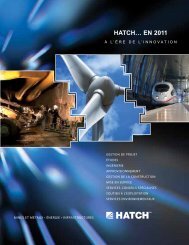
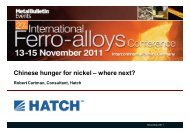
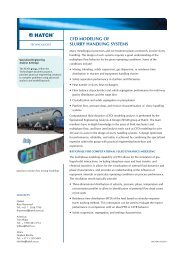
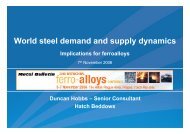

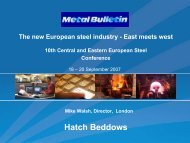

![Presentation: Global Overview of Line Pipe [pdf, 618 KB] - Hatch](https://img.yumpu.com/22183381/1/190x132/presentation-global-overview-of-line-pipe-pdf-618-kb-hatch.jpg?quality=85)
![Sustainable Development Report 2010 [pdf, 2.13 MB] - Hatch](https://img.yumpu.com/22183361/1/190x245/sustainable-development-report-2010-pdf-213-mb-hatch.jpg?quality=85)
![This is Hatch 2011 - Our Organization [pdf, 636 KB]](https://img.yumpu.com/22183357/1/190x245/this-is-hatch-2011-our-organization-pdf-636-kb.jpg?quality=85)
![Annual Review - This is Hatch 2006 [pdf, 1.88 MB]](https://img.yumpu.com/22183355/1/190x245/annual-review-this-is-hatch-2006-pdf-188-mb.jpg?quality=85)
![Hatch Safety Report 2007 [pdf, 2.89 MB]](https://img.yumpu.com/22183353/1/190x245/hatch-safety-report-2007-pdf-289-mb.jpg?quality=85)
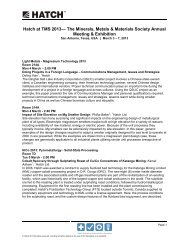
![Structural Assets Newsletter #16, October 2002 [pdf, 322 KB] - Hatch](https://img.yumpu.com/22183350/1/184x260/structural-assets-newsletter-16-october-2002-pdf-322-kb-hatch.jpg?quality=85)
